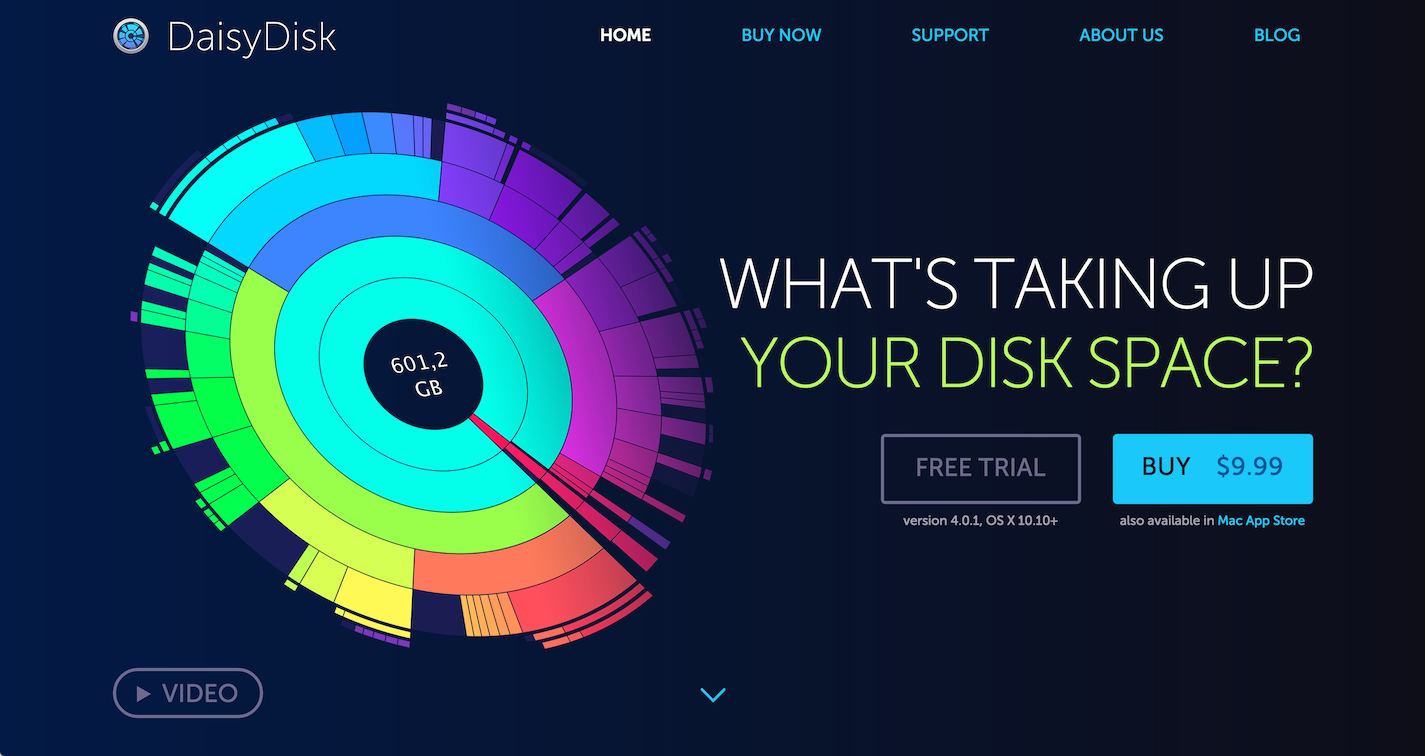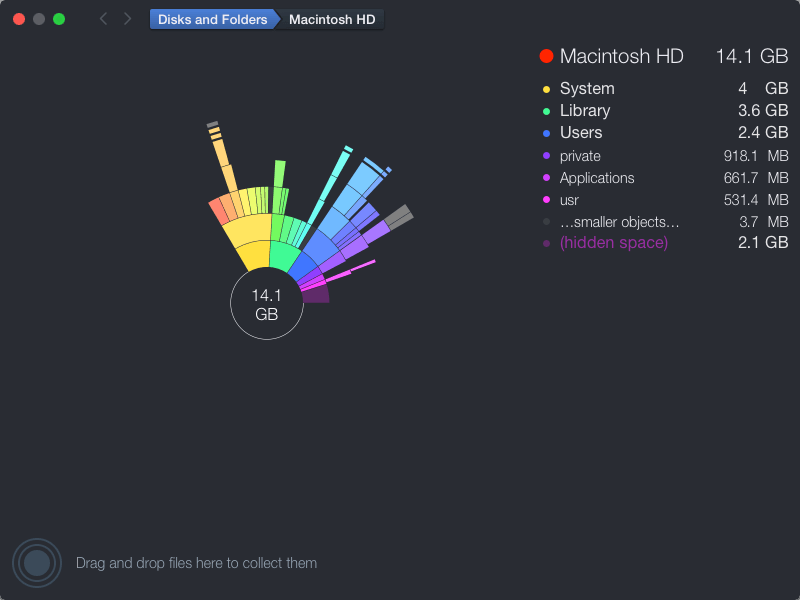| Developer(s) | Software Ambience |
|---|---|
| Initial release | 2008 |
| Stable release | 4.10 (March 8, 2020; 41 days ago[1]) [±] |
| Operating system | macOS |
| Available in | English, German, French, Italian, Russian, Simplified Chinese, Traditional Chinese, Japanese, Swedish, Spanish, Polish[2] |
| Type | Disk space analyzer |
| Website | daisydiskapp.com |
| Usage | |
DaisyDisk is a paid disk space analyzer for macOS.[3] It displays a sunburst diagram of files on a hard drive to help with the location or deletion of large files.[4] It can display previews of files using Quick Look.[5][6][7] It also allows the user to look at the file directly in Finder, in order to delete it or move it elsewhere.[8]

All you have to do is share this Giveaway post on Twitter with the hashtags #MacHow2 and #DaisyDisk and 3 winners will be picked at random to get a full license of DaisyDisk worth $9.99. The latest version of DaisyDisk is great for helping macOS Catalina users recover precious disk space that many found mysteriously disappeared after updating.
History[edit]

DaisyDisk was started in late 2008 by interaction designer Taras Brizitsky and programmer Oleg Krupnov. They built the codebase from scratch to try to achieve higher speeds than similar programs. They decided to use a sunburst diagram as it is perceived better than other ways of visualizing data (such as treemaps).[9]
Features[edit]

DaisyDisk needs to scan the disk to create a map of its files and folders. Once the initial scan is completed, DaisyDisk keeps all displayed information up to date and reflects all changes to disk in real-time. DaisyDisk can scan multiple disks in parallel.
With v4.5[10] of DaisyDisk, support for APFS was added.[11]
Interface[edit]
DaisyDisk displays the contents as a color-coded sunburst diagram, resembling the petals of a daisy.[12] The interface places the root of the hard drive at the center of this daisy, and displays a hierarchical structure of that hard drive's file system that radiates from that center. This daisy is color-coded to differentiate between folders, while files themselves are always displayed as gray. In the right sidebar of the interface, DaisyDisk also provides a legend for these color codes. When hovering over a file or folder, the right sidebar of the interface updates with contextual information such as the file or folder name and their absolute path.[13] When clicking on a folder on the daisy, a new daisy is displayed with the chosen folder as its root. The interface shows a 'breadcrumb trail' of the current folder right above the sunburst diagram.[6]
DaisyDisk provides a Trash-like collector icon in the lower left of its interface where files and folders can dragged and dropped for deletion.[13]
As of DaisyDisk v3, a specialized version of the app exists for Mac users with Retina Displays.[14]
Integration[edit]
One of the ways DaisyDisk integrates with the Mac features is through its support of the Quick Look function, which is included in Mac OS X v10.5 'Leopard' and later. Hovering over any file or folder in DaisyDisk's interface and pressing space bar utilizes Quick Look and displays additional information about that file or folder in regards to its location and contents.[12]
References[edit]
- ^'DaisyDisk Release Notes'. Retrieved 9 March 2020.
- ^'DaisyDisk Blog'. Software Ambience.
- ^'DaisyDisk 4.6.2 free download for Mac'. MacUpdate. Retrieved 19 June 2018.
- ^'DaisyDisk 4 Review'. Macworld. Retrieved 19 June 2018.
- ^'DaisyDisk: Tom's Mac Software Pick'. Lifewire. Retrieved 11 March 2019.
- ^ ab'DaisyDisk: Futuristic Data Visualization'. Mac.AppStorm. Retrieved 20 June 2018.
- ^'How to identify the biggest space wasters on your Mac with DaisyDisk'. iDownloadBlog. Retrieved 19 June 2018.
- ^'Make Your HD Bigger with DaisyDisk for Mac [Review]'. Cult of Mac. Retrieved 11 March 2019.
- ^'An Evaluation of Space-Filling Information Visualizations for Depicting Hierarchical Structures'(PDF). Georgia Institute of Technology. Retrieved 2 June 2010.
- ^'Top 5 questions about APFS and macOS High Sierra asked by Mac users'. DaisyDisk Blog. Retrieved 20 June 2018.
- ^'How to free up disk space in macOS High Sierra'. Cult of Mac. Retrieved 20 June 2018.
- ^ ab'Review: DaisyDisk: Disk Visualization and Analyzer Tool for the Mac'. aboutTechnology. Retrieved 13 November 2014.
- ^ ab'Make Your HD Bigger with DaisyDisk for Mac [Review]'. Cult of Mac. Retrieved 13 November 2014.
- ^'DaisyDisk Blog'. Software Ambience. 7 September 2013. Retrieved 5 January 2019.
DaisyDisk is our favorite tool for finding which files are hogging precious disk space on your Mac and we’ve got 3 licenses of DaisyDisk to giveaway to MacHow2 readers.
All you have to do is share this Giveaway post on Twitter with the hashtags #MacHow2 and #DaisyDisk and 3 winners will be picked at random to get a full license of DaisyDisk worth $9.99.
The latest version of DaisyDisk is great for helping macOS Catalina users recover precious disk space that many found mysteriously disappeared after updating.
You May Also Like:
macOS Catalina takes “snapshots” of your Mac’s hard drive as a way of backing-up but the problem with this is it takes a lot of disk space.
DaisyDisk can locate and find these snapshots allowing you to delete or get rid of them to clear space on your hard drive.
The latest version of DaisyDisk adds new ways of recovering disk space on your Mac including:
Daisydisk Mac Os 7
- Purgeable Space: DaisyDisk allows you to forceable delete this data which
- Snapshots: You can drag, drop and delete the snapshots that you don’t need – this is really effective way of freeing-up space in macOS Catalina.
- Other Volumes: This is any remaining space that DaisyDisk detects that is used internally by macOS
Daisydisk Mac Os 10
Even if you choose not to delete the resource hogging files that DaisyDisk detects, it gives a fascinating insight into where all of your hard space is going.
This competition is open until Sunday 15th March 23:59 PST and only tweets made before the deadline will be considered.
You can read more about what DaisyDisk can do here.